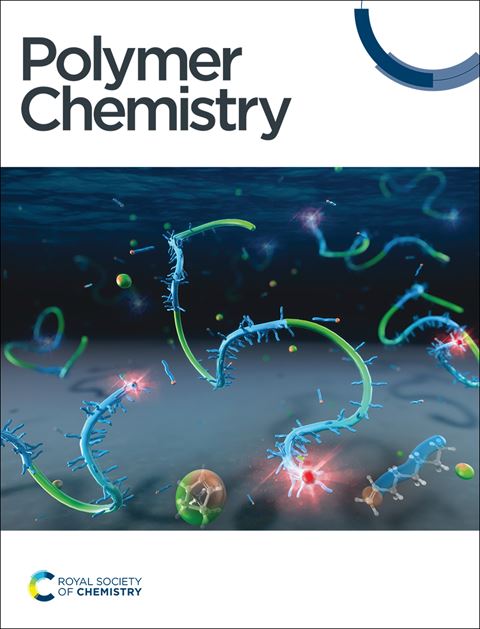Mixed-mode interpenetrating polymer networks from polymerizable eutectics†
IF 4.1
2区 化学
Q2 POLYMER SCIENCE
引用次数: 0
Abstract
The preparation of interpenetrating polymer networks (IPNs) and semi-interpenetrating polymer networks (semi-IPNs) is reported via a solvent-free approach using a binary polymerizable eutectic. N-Isopropylacrylamide (NIPAM) and ε-caprolactone (CL) were mixed in various mole ratios to prepare viscous polymerizable liquids that were stable at room temperature, based on solid–liquid equilibrium phase diagrams from differential scanning calorimetry (DSC) data. The strong degree of association between NIPAM and CL within these mixtures was confirmed via 1D and 2D NMR spectroscopy. Using an appropriate UV photoinitiator and ring opening polymerization catalyst, the orthogonal polymerization (either in a sequential or simultaneous fashion) of each component within the eutectic was achieved, with enhanced reaction kinetics for the ring opening polymerization compared to a traditional solvent (DMSO). Through the incorporation of diacrylate and bis(carbonate) crosslinkers into the resin mixture, IPNs and semi-IPNs were realised in a one-pot two-step approach from polymerizable eutectics for the first time. These networks possessed thermoresponsive swelling behaviour in water, and retained their structural integrity in good solvents for both phases. This binary eutectic was also shown to be suitable as a resin for stereolithography 3D printing on a benchtop printer through the inclusion of a RAFT agent, achieving semi-IPN printed objects in a two-step approach.

来自可聚合共晶的混合模式互穿聚合物网络
报告采用二元可聚合共晶,通过无溶剂方法制备了互穿聚合物网络(IPN)和半互穿聚合物网络(semi-IPN)。根据差示扫描量热法(DSC)数据绘制的固液平衡相图,以不同的摩尔比混合 N-异丙基丙烯酰胺(NIPAM)和ε-己内酯(CL),制备出室温下稳定的粘性可聚合液体。一维和二维核磁共振光谱证实了 NIPAM 和 CL 在这些混合物中的紧密结合程度。通过使用适当的紫外光引发剂和开环聚合催化剂,共晶中的每种成分都实现了正交聚合(顺序聚合或同时聚合),与传统溶剂(DMSO)相比,开环聚合的反应动力学得到了增强。通过在树脂混合物中加入二丙烯酸酯和双(碳酸酯)交联剂,首次以可聚合共晶体为原料,通过一步法和两步法实现了 IPN 和半 IPN。这些网络在水中具有热膨胀性,在两种相的良好溶剂中都能保持结构的完整性。通过加入 RAFT 剂,这种二元共晶体还被证明适用于在台式打印机上进行立体光刻三维打印的树脂,通过两步法实现了半 IPN 打印物体。
本文章由计算机程序翻译,如有差异,请以英文原文为准。
求助全文
约1分钟内获得全文
求助全文
来源期刊

Polymer Chemistry
POLYMER SCIENCE-
CiteScore
8.60
自引率
8.70%
发文量
535
审稿时长
1.7 months
期刊介绍:
Polymer Chemistry welcomes submissions in all areas of polymer science that have a strong focus on macromolecular chemistry. Manuscripts may cover a broad range of fields, yet no direct application focus is required.
 求助内容:
求助内容: 应助结果提醒方式:
应助结果提醒方式:


